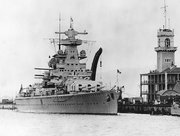Pocket battleship
|
|
Pocket battleship is the British Royal Navy description for a class of warships built by German Reichsmarine in accordance with restrictions imposed by the Treaty of Versailles. They were classified as Panzerschiff ("armoured ship") in German; they were also known as the Deutschland class named after the first ship of this class to be completed. They were smaller than battleships (the displacement was that of a heavy cruiser), but were armed with guns larger than the heavy cruisers of other nations. In fact, they were renamed as heavy cruisers in February 1940. The three ships in the class were launched between 1931 and 1934.

- Deutschland (renamed Lützow in November 1939)
- Admiral Scheer
- Admiral Graf Spee
German capital ships were restricted by the Treaty of Versailles to a displacement of 10,000 tons for "armoured ships". The idea was to limit Germany to pre-dreadnought type ships, which could not challenge the major naval powers of Britain and the United States. A number of technical innovations were used by the Germans to build a formidable warship within this restricted weight; among them were the large-scale use of welding to join hull components together (as opposed to the then-classic rivets), triple-tube main armament turrets, and the use of diesel engines for propulsion. Even so, all members of the class were over that weight limit (first constructed as 10,600 tons, later enlarged to 11,700 resp. 12,100 tons), although for political reasons their announced displacement was always given as the 10,000 tons of the treaty limit.
The principal feature of the pocket battleship design was that it had guns large enough (280mm/11" calibre) to out-gun any enemy cruiser fast enough to catch them, while being fast enough to outrun an enemy powerful enough to sink it. The sole exception were some British and Japanese battlecruisers which were rebuilt as fast battleships. The German naval staff knew this situation would not last, but they hoped for a temporary advantage. The Deutschland class had a speed of 28.5 knots, which was already too slow at the beginning of the second World War (only eight years after the first ship launched).
The same basic design philosophy had led to a generation of ships just prior to World War I known as battlecruisers. In practice fleet commanders forced the battlecruisers to operate along with the larger dreadnoughts, and they suffered badly (see Battle of Jutland for details).
The German Kriegsmarine, which on the outbreak of World War II was years away from having a large surface fleet, was careful not to make the same mistake, and during the war, the Germans intended to use the Panzerschiff vessels purely as commerce raiders on the high seas. In the early years of the conflict, before the Allies closed the air gap over the North Atlantic, developed better Huff-Duff (radio triangulation equipment) and airborne centimetric radar, and the convoys received escort carrier protection, the pocket battleship's speed and main armament made them very difficult to bring to task, as they could generally avoid any fight they did not like; indeed, they were ordered not to fight enemy ships unless they were greatly stronger than them. Admiral Graf Spee destroyed many British merchant ships before being cornered by three British cruisers in December, 1939. In the ensuing battle of the River Plate she damaged the heavy cruiser HMS Exeter so severely it had to break off the action. However, the German ship was also significantly damaged, and after spending several days trapped at Montevideo, she was scuttled on 17 December, 1939, rather than risk a battle with the blockading British warships. Admiral Scheer made several raids into the North Atlantic, on one occasion sinking the armed merchant cruiser HMS Jervis Bay and several cargo ships after catching a convoy. Deutschland was renamed Lützow to avoid the possibility of a ship named after Germany being sunk. These two ships survived until the last weeks of the war.
See also
Further reading
- Siegfried Breyer, Gerhard Koop, (translated Edward Force), The German Navy At War 1939–1945: Volume 1 - The Battleships (Schiffer, West Chester, 1989)
- Bernard Ireland, Tony Gibbons, Jane's Battleships of the 20th Century (HarperCollins, New York, 1996) pp. 42-43
External links
- More about pocket battleships (http://www.german-navy.de/kriegsmarine/ships/panzerschiffe/index.html)
- Battle of the River Plate (http://www.royal-navy.mod.uk/static/pages/4758.html)de:Panzerschiff
hu:Zsebcsatahajó ja:ポケット戦艦 ms:Kapal tempur poket pl:Pancernik kieszonkowy
